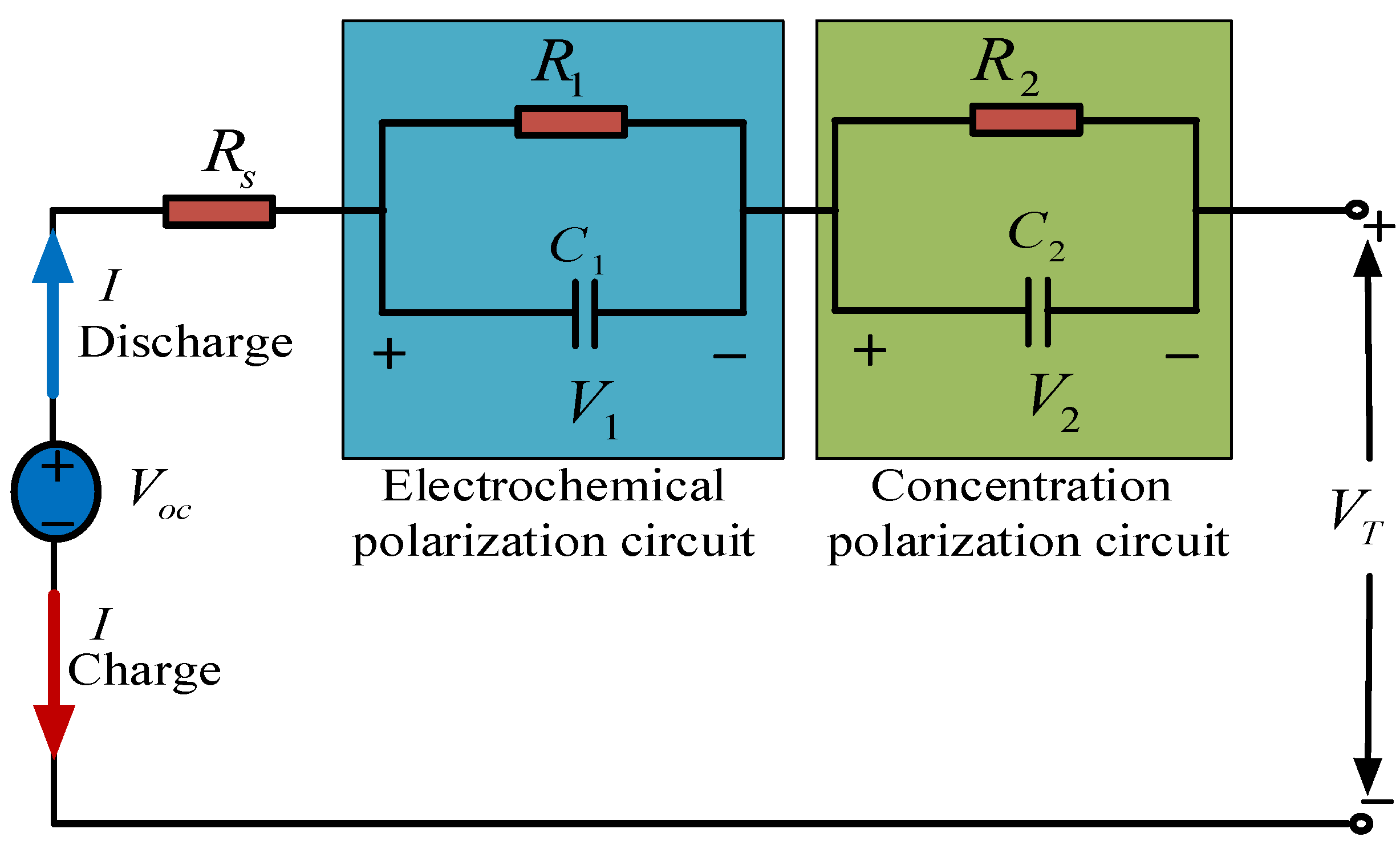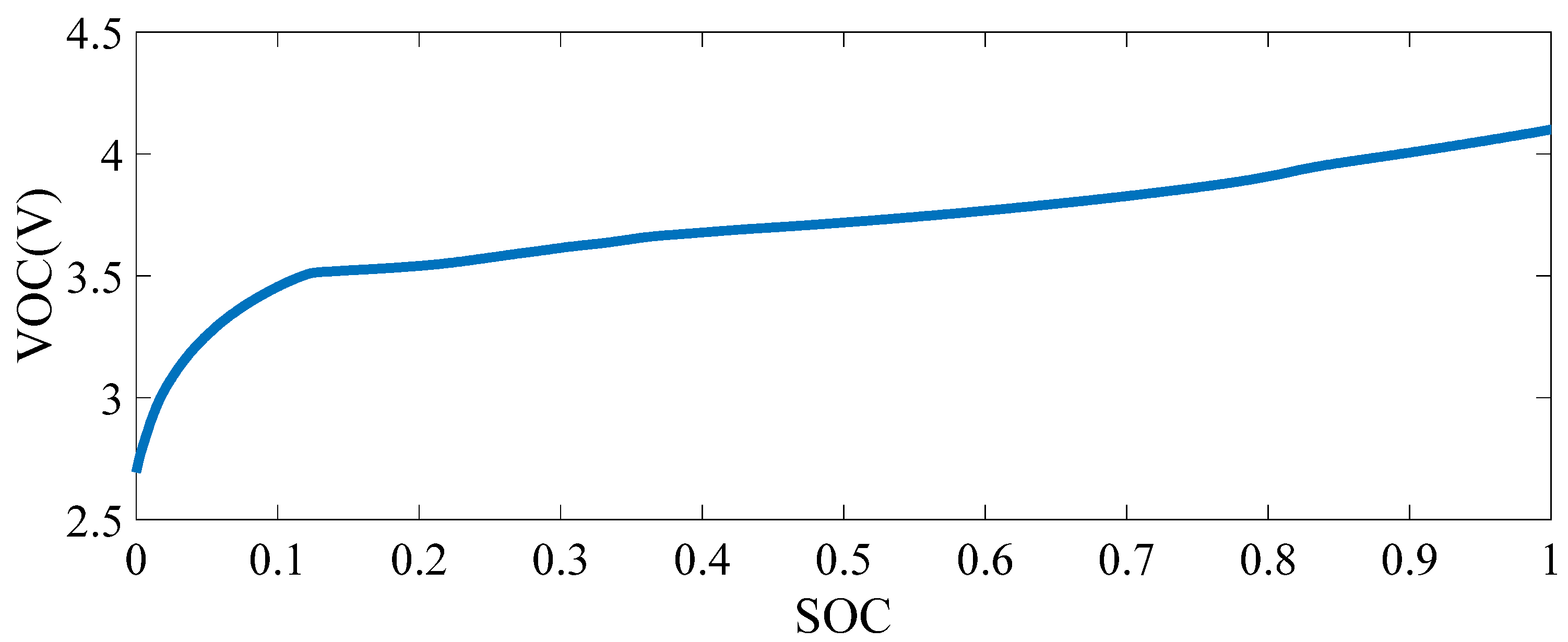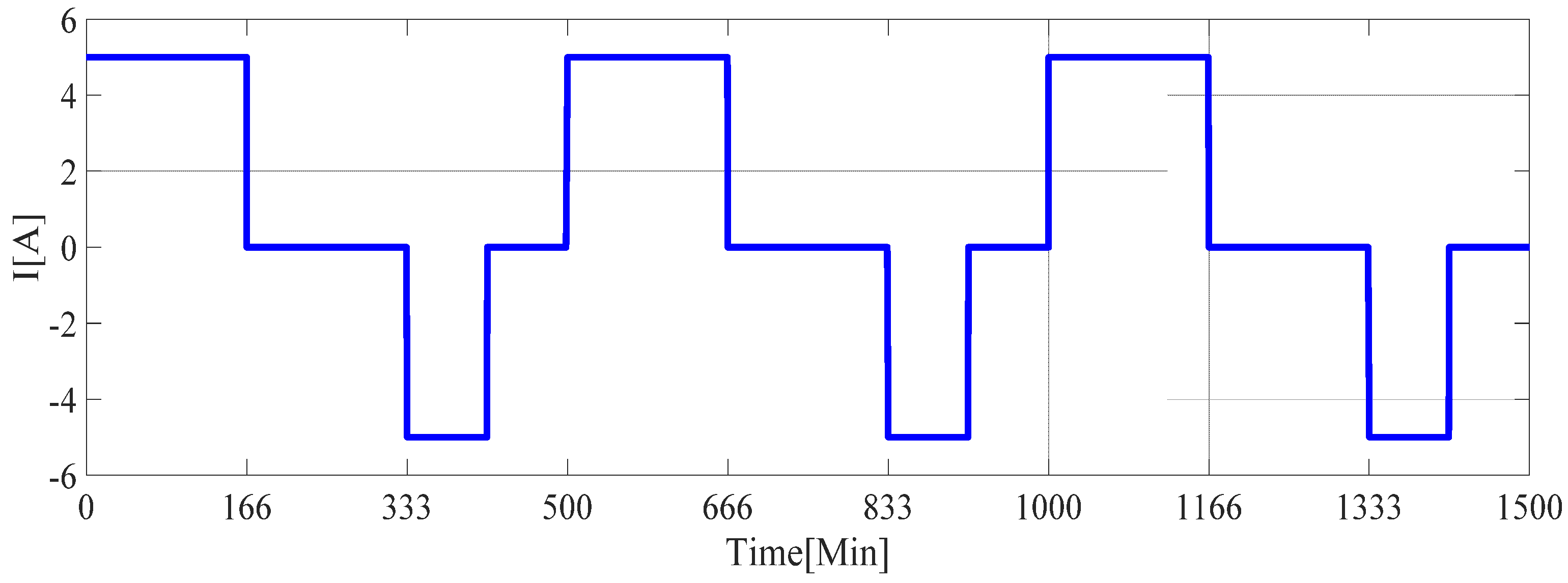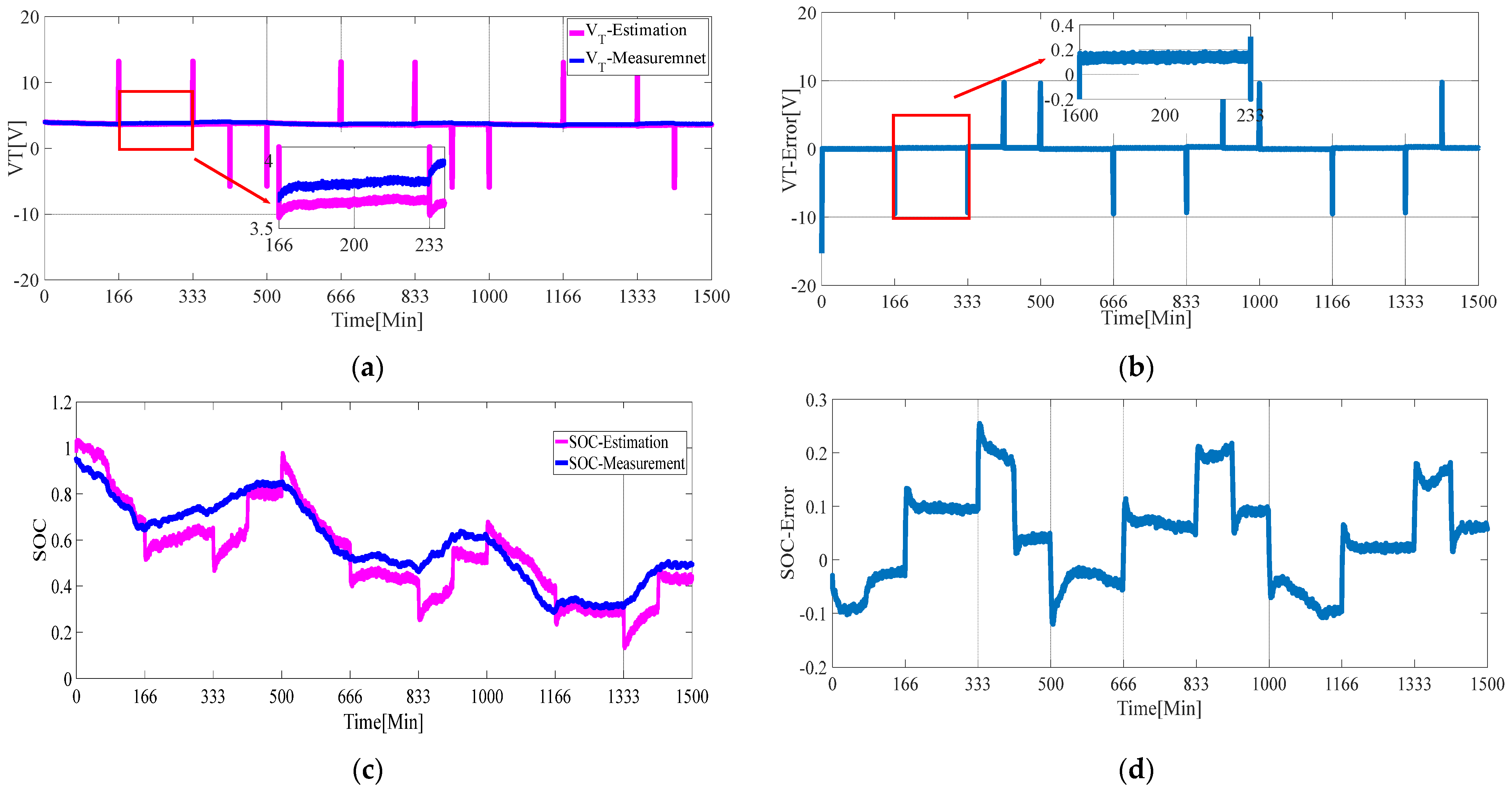A Battery SOC Estimation Method Based on AFFRLS-EKF
Abstract
:1. Introduction
- The paper proposed an AFFRLS–EKF SOC estimation strategy based on parameter identification modeling aiming at the uncertainty of battery model parameters under the condition of abrupt change of battery charge and discharge.
- The second-order Thevenin equivalent circuit model (2-order ECM) of the battery was established, and the SOC–OCV relationship was obtained. According to the charging and discharging conditions, a segment-adaptive recursive least square algorithm was designed to identify the parameters to improve the model accuracy.
- The proposed estimation strategy is applied to numerical simulation experiments, and RLS–EKF and AFFRLS–EKF are compared. The latter one has better performance in accuracy and robustness.
2. Equivalent Circuit Model
3. Adaptive Forgetting Factor Regression Least Squares
4. Simulation Results and Analysis
5. Conclusions
Author Contributions
Funding
Institutional Review Board Statement
Informed Consent Statement
Data Availability Statement
Conflicts of Interest
References
- Gabbar, H.A.; Othman, A.M.; Abdussami, M.R. Review of Battery Management Systems (BMS) Development and Industrial Standards. Technologies 2021, 9, 28. [Google Scholar] [CrossRef]
- Hu, Y.; Wang, Y. Two Time-Scaled Battery Model Identification with Application to Battery State Estimation. IEEE Trans. Control. Syst. Technol. 2015, 23, 1180–1188. [Google Scholar] [CrossRef]
- Zhang, Y.; Ai, Z.; Chen, J.; You, T.; Du, C.; Deng, L. Energy-Saving Optimization and Control of Autonomous Electric Vehicles 261 with Considering Multiconstraints. IEEE Trans. Cybern. 2021, 1–13. [Google Scholar] [CrossRef]
- Lipu, M.S.H.; Hannan, M.A.; Ayob, A.; Saad, M.H.M.; Hussain, A. Review of lithium-ion battery state of charge estimation methodologies for electric vehicle application. Int. J. Eng. Technol. 2018, 7, 219–224. [Google Scholar]
- Zhang, Y.; Song, W.; Lin, S.; Feng, Z. A novel model of the initial state of charge estimation for LiFePO4 batteries. J. Power Sources 2014, 248, 1028–1033. [Google Scholar] [CrossRef]
- Kwak, M.; Lkhagvasuren, B.; Park, J.; You, J. Parameter Identification and SOC Estimation of a Battery under the Hysteresis Effect. IEEE Trans. Ind. Electron. 2020, 67, 9758–9767. [Google Scholar] [CrossRef]
- Farmann, A.; Waag, W.; Marongiu, A.; Sauer, D.U. Critical review of on-board capacity estimation techniques for lithium-ion batteries in electric and hybrid electric vehicles. J. Power Sources 2016, 281, 114–130. [Google Scholar] [CrossRef]
- Zhu, W.; Sun, Q.; Gao, H. Optimized SOC estimation method for ICDKF battery based on online parameter identification. Chin. J. Power Resour. 2020, 44, 97–102. [Google Scholar]
- Xing, Y.; Ma, E.W.M.; Tsui, K.L.; Pecht, M. Battery Management Systems in Electric and Hybrid Vehicles. Energies 2011, 4, 1840–1857. [Google Scholar] [CrossRef]
- Lelie, M.; Braun, T.; Knips, M.; Nordmann, H.; Ringbeck, F.; Zappen, H.; Sauer, D.U. Battery Management System Hardware Concepts: An Overview. Appl. Sci. 2018, 8, 534. [Google Scholar] [CrossRef] [Green Version]
- Lee, J.; Kim, J.-M.; Yi, J.; Won, C.-Y. Battery Management System Algorithm for Energy Storage Systems Considering Battery Efficiency. Electronics 2021, 10, 1859. [Google Scholar] [CrossRef]
- Samanta, A.; Chowdhuri, S.; Williamson, S.S. Machine Learning-Based Data-Driven Fault Detection/Diagnosis of Lithium-Ion Battery: A Critical Review. Electronics 2021, 10, 1309. [Google Scholar] [CrossRef]
- Aiello, O. Electromagnetic Susceptibility of Battery Management Systems’ ICs for Electric Vehicles: Experimental Study. Electronics 2020, 9, 510. [Google Scholar] [CrossRef] [Green Version]
- Kang, T.; Park, S.; Lee, P.-Y.; Cho, I.-H.; Yoo, K.; Kim, J. Thermal Analysis of a Parallel-Configured Battery Pack (1S18P) Using 21700 Cells for a Battery-Powered Train. Electronics 2020, 9, 447. [Google Scholar] [CrossRef] [Green Version]
- Abbas, M.; Cho, I.; Kim, J. Analysis of High-Power Charging Limitations of a Battery in a Hybrid Railway System. Electronics 2020, 9, 212. [Google Scholar] [CrossRef] [Green Version]
- Arnieri, E.; Boccia, L.; Amoroso, F.; Amendola, G.; Cappuccino, G. Improved Efficiency Management Strategy for Battery-Based Energy Storage Systems. Electronics 2019, 8, 1459. [Google Scholar] [CrossRef] [Green Version]
- Lee, S.; Kim, J. Power Capability Analysis of Lithium Battery and Supercapacitor by Pulse Duration. Electronics 2019, 8, 1395. [Google Scholar] [CrossRef] [Green Version]
- Uno, M.; Ueno, T.; Yoshino, K. Cell Voltage Equalizer Using a Selective Voltage Multiplier with a Reduced Selection Switch Count for Series-Connected Energy Storage Cells. Electronics 2019, 8, 1303. [Google Scholar] [CrossRef] [Green Version]
- Lee, H.; Park, J.; Kim, J. Incremental Capacity Curve Peak Points-Based Regression Analysis for the State-of-Health Prediction of a Retired LiNiCoAlO2 Series/Parallel Configured Battery Pack. Electronics 2019, 8, 1118. [Google Scholar] [CrossRef] [Green Version]
- Sun, F.; Hu, X.; Yuan, Z.; Li, S. Adaptive unscented Kalman filtering for state of charge estimation of a lithium-ion battery for electric vehicles. Fuel. Energy. Abs. 2014, 5, 3531–3540. [Google Scholar] [CrossRef]
- Lim, K.C.; Bastawrous, H.A.; Duong, V.H.; See, K.W.; Zhang, P.; Dou, S.X. Fading Kalman filter-based real-time state of charge estimation in LiFePO4 battery-powered electric vehicles. Appl. Energy 2016, 169, 40–48. [Google Scholar] [CrossRef]
- He, H.; Xiong, R.; Zhang, X.; Sun, F.; Fan, J. State-of-Charge Estimation of the Lithium-Ion Battery Using an Adaptive Extended Kalman Filter Based on an Improved Thevenin Model. IEEE Trans. Veh. Technol. 2011, 4, 1461–1469. [Google Scholar]
- He, Z.; Yang, Z.; Cui, X.; Li, E. A Method of State-of-Charge Estimation for EV Power Lithium-Ion Battery Using a Novel Adaptive Extended Kalman Filter. IEEE Trans. Veh. Technol. 2020, 69, 14618–14630. [Google Scholar] [CrossRef]
- Song, Q.; Mi, Y.; Lai, W. A Novel Variable Forgetting Factor Recursive Least Square Algorithm to Improve the Anti-Interference Ability of Battery Model Parameters Identification. IEEE Access. 2019, 7, 61548–61557. [Google Scholar] [CrossRef]
- Xie, W.; Zhao, Y.; Fang, Z.; Liu, S. Parameter Identification Method for Equivalent Model of Supercapacitor Module with Variable Forgetting Factor Recursive Least Square Method. Trans. Chin. Electron. Soc. 2021, 5, 996–1005. [Google Scholar]
- Rijanto, E.; Rozaqi, L.; Nugroho, A.; Kanarachos, S. RLS with optimum multiple adaptive forgetting factors for SoC and SoH estimation of Li-Ion battery. In Proceedings of the 2017 5th International Conference on Instrumentation, Control, and Automation (ICA), Yogyakarta, Indonesia, 9–11 August 2017; IEEE Computer Society: Washington, DC, USA, 2017. [Google Scholar]
- Li, Y.; Chen, J.; Lan, F. Enhanced online model identification and state of charge estimation for lithium-ion battery under noise corrupted measurements by bias compensation recursive least squares. J. Power Sources 2020, 456, 227984. [Google Scholar] [CrossRef]
- Wei, Z.; Zhao, J.; Ji, D.; Tseng, K.J. A multi-timescale estimator for battery state of charge and capacity dual estimation based on an online identified model. Appl. Energy 2017, 204, 1264–1274. [Google Scholar] [CrossRef]
- Sun, D.; Chen, X. Adaptive parameter identification method and state of charge estimation of lithium ion battery. In Proceedings of the 2014 17th International Conference on Electrical Machines and Systems (ICEMS), Hangzhou, China, 22–25 October 2014; IEEE Computer Society: Washington, DC, USA, 2014. [Google Scholar]
- Qiu, Y.; Li, X.; Chen, W.; Duan, Z.; Yu, L. State of charge estimation of vanadium redox battery based on improved extended Kalman filter. ISA Trans. 2019, 94, 26–337. [Google Scholar] [CrossRef]
- Corno, M.; Bhatt, N.; Savaresi, S.M.; Verhaegen, M. Electrochemical model-based state of charge estimation for Li-ion cells. IEEE Trans. Control Syst. Technol. 2015, 23, 117–127. [Google Scholar] [CrossRef]
- Fan, G.; Li, X.; Canova, M. A reduced-order electrochemical model of li-ion batteries for control and estimation applications. IEEE Trans. Veh. Technol. 2018, 67, 76–91. [Google Scholar] [CrossRef]
- Prada, E.; Di Domenico, D.; Creff, Y.; Bernard, J.; Sauvant-Moynot, V.; Huet, F. Simplified electrochemical and thermal model of LiFePO4 -graphite Li-Ion batteries for fast charge applications. J. Electrochem. Soc. 2012, 159, A1508–A1519. [Google Scholar] [CrossRef] [Green Version]
- He, H.; Xiong, R.; Fan, J. Evaluation of lithium-ion battery equivalent circuit models for state of charge estimation by an experimental approach. Energies 2011, 4, 582–598. [Google Scholar] [CrossRef]
- Xiong, R.; Sun, F.; Chen, Z.; He, H. A data-driven multi-scale extended Kalman filtering based parameter and state estimation approach of lithium-ion olymer battery in electric vehicles. Appl. Energy. 2014, 113, 463–476. [Google Scholar] [CrossRef]
- Xiong, R.; Sun, F.-C.; He, H.-W. Data-driven state-of-charge estimator for electric vehicles battery using robust extended Kalman filter. Int. J. Automot. Technol. 2014, 15, 89–96. [Google Scholar] [CrossRef]
- Westerhoff, U.; Kroker, T.; Kurbach, K.; Kurrat, M. Electrochemical impedance spectroscopy based estimation of the state of charge of lithium-ion batteries. J. Energy Storage 2016, 8, 244–256. [Google Scholar] [CrossRef]
- Available online: https://github.com/jdorsey22/298-Estimation-Theory/blob/master/EKF/DataFiles/IV_data_nonlinear.mat (accessed on 1 January 2021).
- Yu, Q.Q.; Xiong, R.; Wang, L.Y.; Lin, C. A comparative study on open circuit voltage models for Lithium-ion batteries. Chin. J. Mech. Eng. 2018, 31, 651–658. [Google Scholar] [CrossRef] [Green Version]
- Zhang, T.; Yang, S.; Hu, J.; Gao, J.; Liu, D. State of charge estimation of lithium battery based on FFRLS-SRUKF algorithm. In Proceedings of the 2020 IEEE 3rd International Conference on Electronics Technology (ICET), Chengdu, China, 8–11 May 2020; IEEE Computer Society: Washington, DC, USA, 2020. [Google Scholar]
- Luo, X.; Kang, L.; Lu, C.; Linghu, J.; Lin, H.; Hu, B. An Enhanced Multicell-to-Multicell Battery Equalizer Based on Bipolar-Resonant LC Converter. Electronics 2021, 10, 293. [Google Scholar] [CrossRef]
- Doridant, A.; Abouda, K.; Givelin, P.; Thibaud, B. Battery Management System Demonstrator Board design using EMC System simulation. In Proceedings of the 2019 International Symposium on Electromagnetic Compatibility—EMC EUROPE, Barcelona, Spain, 2–6 September 2019. [Google Scholar]







| SOC | VOC | SOC | VOC | SOC | VOC |
|---|---|---|---|---|---|
| 0% | 2.6936 | 35% | 3.6504 | 70% | 3.8270 |
| 5% | 3.2567 | 40% | 3.6776 | 75% | 3.8627 |
| 10% | 3.4552 | 45% | 3.6982 | 80% | 3.9073 |
| 15% | 3.5220 | 50% | 3.7184 | 85% | 3.9628 |
| 20% | 3.5408 | 55% | 3.7414 | 90% | 4.0056 |
| 25% | 3.5750 | 60% | 3.7670 | 95% | 4.0510 |
| 30% | 3.6144 | 65% | 3.7954 | 100% | 4.1000 |
| 1 Parameter initialization: , |
| 2 State Prediction: |
| 3 Kalman filter gain: |
| 4 Measure values updated: |
| 5 Posteriori estimates: |
Publisher’s Note: MDPI stays neutral with regard to jurisdictional claims in published maps and institutional affiliations. |
© 2021 by the authors. Licensee MDPI, Basel, Switzerland. This article is an open access article distributed under the terms and conditions of the Creative Commons Attribution (CC BY) license (https://creativecommons.org/licenses/by/4.0/).
Share and Cite
Li, M.; Zhang, Y.; Hu, Z.; Zhang, Y.; Zhang, J. A Battery SOC Estimation Method Based on AFFRLS-EKF. Sensors 2021, 21, 5698. https://doi.org/10.3390/s21175698
Li M, Zhang Y, Hu Z, Zhang Y, Zhang J. A Battery SOC Estimation Method Based on AFFRLS-EKF. Sensors. 2021; 21(17):5698. https://doi.org/10.3390/s21175698
Chicago/Turabian StyleLi, Ming, Yingjie Zhang, Zuolei Hu, Ying Zhang, and Jing Zhang. 2021. "A Battery SOC Estimation Method Based on AFFRLS-EKF" Sensors 21, no. 17: 5698. https://doi.org/10.3390/s21175698
APA StyleLi, M., Zhang, Y., Hu, Z., Zhang, Y., & Zhang, J. (2021). A Battery SOC Estimation Method Based on AFFRLS-EKF. Sensors, 21(17), 5698. https://doi.org/10.3390/s21175698







